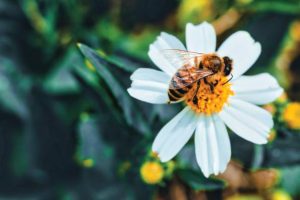Florida’s Roadside Wildflowers Create Pollinator Habitats
In partnership with: Florida Department of Agriculture and Consumer Services

It’s not uncommon to see swaths of colorful wildflowers growing along the roadsides in Florida. The wildflowers offer more than just a pretty view for drivers navigating the highways and byways that crisscross the state. Each roadside flower patch provides important pollinator habitats.
“Traditionally, wildflower plantings were put in place for beautification of roadways,” explains Jaret Daniels, curator of the Florida Museum of Natural History’s McGuire Center for Lepidoptera and Biodiversity. “In recent years, there’s been much more of an understanding that it’s way more than that. It’s also providing many ecosystem benefits.”
See more: Florida Pollinators Are Sweeter Than Honey

Driving Pollination
The Florida Department of Transportation (FDOT) launched its Wildflower Program in 1963.
Roadsides might not seem like the ideal location for wildflowers. Still, Lisa Roberts, former executive director of the Florida Wildflower Foundation, the nonprofit that partners with FDOT to manage the roadside habitat program, notes that open spaces and full sun allow the colorful blooms to thrive.
Over time, the focus of the Wildflower Program has changed from planting new stands of wildflowers to altering management practices, including reduced mowing. “No mow” signs were installed in wildflower patches to alert FDOT workers that these are managed habitats, not weeds, and serve an essential purpose in the local ecosystem.
Letting wildflowers bloom allows pollinators to take advantage of the pollen, nectar, host plants and nesting sites.
“When we do a management plan for an area and FDOT implements that plan, it’s written into the specifications for that roadside,” Roberts explains. “Depending on the location, a roadside might be mowed just two or three times per year.”
When allowed to flourish, roadside wildflower patches can support a surprising diversity of pollinators from native bumblebees and butterflies to hummingbirds and moths – all species that are declining due to habitat loss. Allowing wildflowers to flourish on roadsides and rights-of-way ensures pollinators and other beneficial insects have access to needed resources.
“How the roadside is mowed and maintained can help support the habitat,” Daniels says. “You don’t have to do much more to enhance biodiversity and key ecosystem services.”

Creating Pollinator Pathways
On its own, each small patch of wildflowers might not seem important, but just like the miles of highway connecting Miami to Jacksonville and Clearwater to Port Saint Lucie, each habitat serves as a rest stop that supports pollinators on their journeys.
Cherrylake, a sustainable landscaping company based in Groveland, wanted to add to Florida’s patchwork of pollinator habitats.
Mark Russell, leader of sustainability initiatives, oversaw the production of several thousand native Florida wildflowers and added them to the 1,800-acre site, which includes 4.5 miles of roadside suitable for planting pollinator and songbird habitat adjacent to the main road through Groveland.
See more: Why Florida is Hailed as a Tropical Paradise
“There was a three-month period when we were planning the site, and during that time, I saw one butterfly,” he recalls. “Two weeks ago, when we finished phase two of the project…there were pollinators everywhere. The difference was remarkable.”
According to Roberts, many of the roadside wildflower patches are adjacent to agricultural land, which means the habitat supports pollinators and helps farmers.
“That habitat [that adjoins agricultural areas] will attract honeybees, native bees and other insect pollinators, and that can transfer easily into an agricultural field,” she says. “It behooves us to keep that wildflower habitat out there. It’s very important to our native insects.”
7 Comments
Join the discussion and tell us your opinion.




Sure would love to see more of this in Jacksonville/Duval county (less of non native crepe Myrtles in gov’t landscaping!!)…
Preach it, Sister! 👍👍👍
We love the roadside wild flowers . Wish we had some in front of our property at 4444 NW Hwy 19 , Steinhatchee .
I’ve seen some in Central Florida and they are beautiful! Could we know what they are planting where? I’d like to know so that can plant similar wildflowers and give our pollinators more another rest stop. Wonderful initiative!
I’d like to know what plants are favorable to butterflies and bees.
Hi Dalia,
Thanks for reaching out! Native plants in your area are always a good idea for supporting pollinator populations. You can read more here:
https://farmflavor.com/lifestyle/garden/7-ways-to-attract-pollinators-to-your-garden/ and find a list of plants here:
https://www.gardeners.com/how-to/attracting-butterflies-hummingbirds/7265.html
Thanks!
Rachel Graf
Digital Editor, Farm Flavor
I’ve tried to do this in a meadow next to my house in Orange Park. But how do you keep the beggar lice from taking over? I’ve been trying to hand pull them, but I end up covered and don’t seem to make a dent. Should I just let them go?